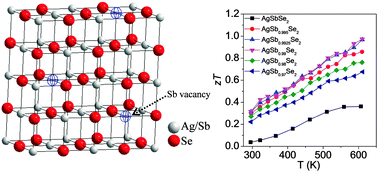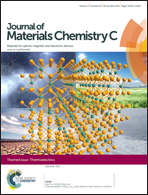Sb deficiencies control hole transport and boost the thermoelectric performance of p-type AgSbSe2†
Abstract
Silver antimony selenide, AgSbSe2, a Te free analogue of AgSbTe2, has been known to show a promising thermoelectric performance when it is doped with monovalent (M+) and divalent (M2+) cations in the Sb sublattice. Here, we report a significant enhancement of the thermoelectric performance of p-type nonstoichiometric AgSbSe2 through Sb deficiencies. Sb deficiencies markedly increase the carrier concentration in AgSbSe2 without the addition of any foreign dopant, which in turn enhances electrical conductivity in the 300–610 K temperature range. Enhancement in the electrical transport results in a remarkable improvement in the power factor (σS2) values up to ∼6.94 μW cm−1 K−2 at 610 K in AgSb1−xSe2. Notably, we have achieved a nearly constant σS2 value of ∼6 μW cm−1 K−2 in the 400–610 K temperature range in Sb deficient samples. Additionally, AgSbSe2 exhibits ultra-low thermal conductivity due to phonon scattering because of bond anharmonicity and a disordered cation sub-lattice. With superior electronic transport and ultra-low thermal conductivity, a peak ZT value of ∼1 at 610 K was achieved for the AgSb0.9925Se2 and AgSb0.99Se2 samples. A maximum thermoelectric conversion efficiency (ηmax) of ∼8% was calculated by considering a virtual thermoelectric module consisting of the present p-type AgSb1−xSe2 and previously reported n-type AgBiSe2−xClx, by maintaining a temperature difference of ΔT = 400 K.

- This article is part of the themed collection: The Chemistry of Thermoelectric Materials

 Please wait while we load your content...
Please wait while we load your content...